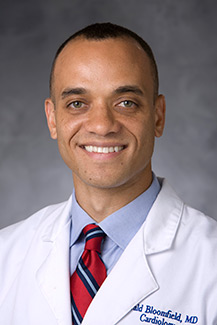Finding causes of heart failure in Western Kenya
20th Anniversary of Global Health Fellows and Scholars

When Fogarty first launched its Global Health Fellows and Scholars Program, now known as
Launching Future Leaders in Global Health Research Training Program (LAUNCH), in 2004, many candidates were focused on some combination of HIV/AIDS, public health, or infectious disease research. Yet, as the cohorts grew, so did the diversity of specialties. An example is Dr. Gerald Bloomfield, who joined the Fogarty program in 2009 as a member of the first group of cardiologist fellows. This original cohort of heart doctors paved the way for other cardiologists to enter the program.
The premise of Bloomfield's Fogarty project was to search for markers of atherosclerosis in heart failure patients in Western Kenya. At that time, atherosclerosis, a buildup of plaque and cholesterol on the wall of the arteries, wasn't thought to be a common cause of heart disease or heart failure in places like Kenya. His team conducted a case-controlled study of patients with and without heart failure. They found that the most common causes of heart failure in the region, including untreated high blood pressure, matched precisely what was described in the literature. However, amongst men, markers of atherosclerosis were the second most common cause of heart failure in the 300 study participants. Bloomfield said, "While atherosclerosis certainly is not the number one cause of heart failure in Western Kenya, it is becoming much more common than it was decades ago."
During his fellowship in Kenya, Bloomfield observed an epidemic of heart failure and high blood pressure and quickly realized there was a lack of expertise available. To address these issues, he and his mentors developed a Cardiovascular Center of Excellence to conduct research, provide multidisciplinary training, and enhance care delivery for heart disease patients.
He and his colleagues also found an interesting overlap with heart failure among people living with HIV who had well-controlled disease, something he went on to study in 2011 through a Fogarty International Research Scientist Development Award with additional funding from the National Heart, Lung, and Blood Institute. In Western Kenya, he continues this research by investigating subclinical cardiac dysfunction—heart conditions that might be asymptomatic or undetected by the usual clinical tests—among people living with HIV, including children and adolescents with perinatal (pre-birth) HIV infection.
His work in Kenya continues, yet Bloomfield also applies what he has learned globally to local settings in the United States. He currently leads a project looking at best practices in heart disease care for people living with HIV in the Southern U.S., working to understand when and how a cardiologist should get involved in their care and what types of referrals and consultations would be required. Additionally, Bloomfield is heading a study in rural areas of Southern U.S. that uses non-invasive imaging to study heart function and detect early dysfunction. When he is not involved with research, Bloomfield continues his work at Duke University as a clinician and as an associate professor in the department of medicine with a secondary appointment in the Global Health Institute, where he teaches a master's level course in noncommunicable diseases in low-and-middle-income countries.
Bloomfield credits his Fogarty fellowship as the stepping stone to where he is today and welcomes opportunities to give back. Since his own fellowship in 2009, he has mentored several of the dozens of cardiologists who have gone through the program. "It's been fantastic to see prior mentees now leading noncommunicable disease programs, holding academic positions, and doing public health work internationally and in the U.S.," said Bloomfield. "Fogarty fellows are very engaged and passionate about their work, and it's been great to help them get to the next stage in their career."
His advice to future fellows is to really use their Fogarty year and go
all in when entering the global health research space. "Lean in. This year has the potential to be a pivotal point in your career and will open many other doors."
More Information
Updated March 9, 2023
To view Adobe PDF files,
download current, free accessible plug-ins from Adobe's website.
Related Fogarty Programs
Related World Regions / Countries
Related Global Health Research Topics